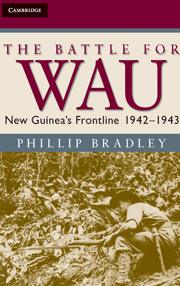Book contents
- Frontmatter
- Dedication
- Contents
- List of illustrations
- Foreword by Peter Ryan
- Acknowledgements
- Prologue
- 1 Salamaua Falls
- 2 Commandos
- 3 Scorched earth
- 4 Undermined
- 5 Convoy
- 6 Assault on Mubo
- 7 17th Brigade
- 8 ‘They came like the rain’
- 9 ‘Life blood of green’
- 10 Force of arms
- 11 Lost airmen
- 12 Retreat from Wau
- Conclusion
- Notes
- Abbreviations
- Bibliography
- Index
- Frontmatter
- Dedication
- Contents
- List of illustrations
- Foreword by Peter Ryan
- Acknowledgements
- Prologue
- 1 Salamaua Falls
- 2 Commandos
- 3 Scorched earth
- 4 Undermined
- 5 Convoy
- 6 Assault on Mubo
- 7 17th Brigade
- 8 ‘They came like the rain’
- 9 ‘Life blood of green’
- 10 Force of arms
- 11 Lost airmen
- 12 Retreat from Wau
- Conclusion
- Notes
- Abbreviations
- Bibliography
- Index
Summary
The town of Wau, at the head of the Bulolo Valley in what is now Papua New Guinea, had its foundation in gold. It was in the early 1920s that the first gold was found in the Bulolo Valley, with the first miner's right issued in December 1923. As the goldfields developed, the coastal town of Salamaua became their key supply port.
Salamaua lies some 50 kilometres to the northeast of Wau and almost 40 kilometres directly south of Lae across the Huon Gulf. The old town is on the isthmus of a peninsula that juts out into the Solomon Sea like an accusing finger, pointed to the northeast. On 21 October 1925 the first cargo boat, the MV Marsina, called at its port. As the news spread, more people came to Salamaua to head up into the mountains for the promise of riches at Wau. Both towns grew, though that growth would always be limited by the strenuous eight-day trek from the coast up to Wau. An air route was sorely needed.
In 1927 a former Australian officer from the First World War, Cecil Levien, brought 250 native labourers to Lae and constructed a landing ground there. Ray Parer, who had been narrowly beaten by Sir Ross and Keith Smith as the first to fly from England to Australia, flew the first aeroplane, a De Havilland DH-4, from Rabaul to Lae.
- Type
- Chapter
- Information
- The Battle for WauNew Guinea's Frontline 1942–1943, pp. 1 - 19Publisher: Cambridge University PressPrint publication year: 2008

